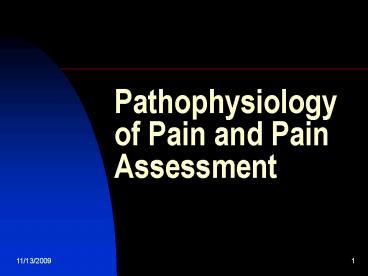Pathophysiology of Pain and Pain Assessment - PowerPoint PPT Presentation
1 / 20
Title:
Pathophysiology of Pain and Pain Assessment
Description:
Psychological or 'Idiopathic' Pain 'We all have pain, yet not everyone suffers' The patient's psychological state contributes significantly to pain and ... – PowerPoint PPT presentation
Number of Views:5877
Avg rating:5.0/5.0
Title: Pathophysiology of Pain and Pain Assessment
1
Pathophysiology of Pain and Pain Assessment
2
Pain is.
- Sensory
- Emotional
- Cognitive
3
. . . . 3 Hierarchical Levels
- Sensory-discriminatory component (location,
intensity, quality) - Motivational-affective component ( depression,
anxiety) - Cognitive-evaluative component (thoughts of
cause, significance of the pain)
4
Who Has Pain?
- 90 of adults more than one day a month
- 42 report pain everyday
- 9 of adults suffer moderate -severe chronic
non-cancer pain (75 million Americans)
5
Pathophysiology
- Nociceptive Pain Mechanisms
- Neuropathic Pain Mechanisms
- Psychological or Idiopathic Pain Mechanisms
6
Nociceptive
- Receptor stimulation (by process causing tissue
injury) - Normal activation (of nociceptive system)
- Afferents A-delta and C-fibers, to dorsal horn,
ascending neural pathways, thalamic,other brain
structures - Acute and/or chronic inflammation
- Sensory/discriminatory, motivational/affective,
cognitive/evaluative
7
Nociceptive Pain Modulation
- Endorphinergic endogenous opioid compounds
acting at mu, delta, kappa receptors - Opioid associated systems that regulate
homeostasis, response to stress, and pain - Serotonin, norepinephrine and other
neurotransmitters also involved
8
Types of Nociceptive Pain
- Acute and Chronic
- Somatic localized,described as aching,
throbbing, stabbing (i.e. arthritis, bone mets) - Visceral generalized, described as cramping,
gnawing, varying intensity, often referred ( I.e.
bowel obstruction)
9
Neuropathic Pain Mechanisms
- Pathophysiologic changes in the peripheral or
central nervous system - Changes become independent of the initial injury
or damage, and can sustain a chronic pain state - Often described as burning, lancinating,
electrical
10
Neuropathic Pain Altered Pain Responses
- Allodynia pain induced by light touch
- Hyperalgesia increased response to noxious
stimuli - Hyperpathia exaggerated responses to painful
stimuli, with continued sensation of pain after
the stimulation has ceased
11
Psychological or Idiopathic Pain
- We all have pain, yet not everyone suffers
- The patients psychological state contributes
significantly to pain and suffering pain is
objective and subjective - Affective and psychological disorders should be
assessed and treated - psychogenic pain
12
Initial Pain Assessment
- History and Physical Exam
- Psychosocial Assessment
- Diagnostic work-up, or review of previous
diagnostic studies and consultations - Assessment should be ongoing, individualized, and
documented - The patient self-report is the gold standard in
assessment
13
Most Experts Believe
- That repeated evaluation of the
- same painful site in a patient with
- long-standing chronic pain rarely
- yields useful results and may divert
- attention from symptom control and
- functional restoration.
14
Assessing Pain Character and Intensity
- Select a method, incorporate it
- Unidimensional Pain Scales
- Verbal Rating Scale (none, mild)
- Numeric Rating Scale (010)
- Visual Analog Scale (10cm line)
- Faces, Color, other scales
- Multidimensional Pain Scales
- McGill Pain Questionnaire
- Memorial Pain Assessment Card
- Brief Pain Inventory
15
Post-Test
16
Which of the following are components of the pain
experience?
- a. Sensory-discriminatory
- b. Motivational-affective
- c. Cognitive-evaluative
- 1. a only
- 2. a and b
- 3. a and c
- 4. All of the above
17
True or False?
- 1. Nociceptive pain involves normal activation by
noxious stimuli - 2. Neuropathic pain involves injury to
peripheral, central nervous system - 3. Nociception with chronic inflammation and
persistent tissue injury can cause chronic pain - 4. Pain that appear idiopathic need not be fully
investigated, as there is no physical cause
18
Which are components of initial pain assessment?
- a. Detailed history, including pain
characteristics and intensity - b. Physical exam, with emphasis on the
neurological examination - c. A psychosocial assessment
- d. An appropriate diagnostic work-up
- 1. a only 2. a and b 3. a,b,c 4. all
19
Which is the best indicator of a patients pain?
- a. Patient self-report
- b. Caregiver accounts
- c. Evaluation of facial expressions
- d. Sympathetic signs and symptoms
- 1. a 2. a and b 3. a,b,c 4. all
20
Which of these tools does not provide a measure
of pain intensity?
- a. Faces Pain Scale
- b. Numeric Rating Scale
- c. Visual Analog Scale
- d. Brief Pain Inventory
- 1. a only 2. d only 3. None 4. all































